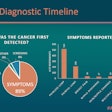Recurrence-free breast cancer survival is less likely in women with high breast density compared to women with low density, according to research published April 18 in The Breast.
A team led by Hanna Sartor, MD, from Lund University in Sweden found that these results were especially evident for women with screening-detected cancers. However, they found no association between mammographic tumor appearance and recurrence-free survival.
This study may lead to insights on risk factors related to tumor biology, mammographic patterns at diagnosis, and breast cancer recurrence, which in turn could be used to tailor surveillance,” the Sartor team wrote.
Surveillance programs post-breast cancer treatment have become more important as reports indicate the number of women living with breast cancer is rising. The researchers highlighted that identifying links between mammographic features and recurrence could help design follow-up strategies. This could lead to earlier detection of recurrence.
Sartor and colleagues analyzed associations between mammographic features at diagnosis and their potential association with recurrence-free survival.
The study included data from 1,082 women who were part of the prospective Malmö Diet and Cancer Study (1991-2014). The women were assessed for locoregional and distant recurrences, with a median follow-up of 10.15 years.
Out of the total women, 265 (24.4%) had recurrent disease. Additionally, the team found ties between high mammographic breast density at diagnosis and impaired recurrent-free survival. This included an adjusted hazard ratio (HR) of 1.32.
The researchers also analyzed data that was limited to screening-detected breast cancer. They reported that the association between high breast density and impaired recurrent-free survival was stronger, with an adjusted HR of 2.12.
The study also found no significant association between recurrent-free survival and separate groups of tumor appearance (p = 0.18). In stratified unadjusted analysis on screen-detected cancers, there was an inverse relation between spiculated tumor masses and impaired recurrence-free survival (overall, p = 0.033; HR, 0.66). However, after adjustments, this association did not achieve statistical significance (overall, p = 0.415; adjusted HR, 0.76).
The study authors wrote that the reason for the ties between high breast density on screen-detected cancers and impaired recurrence-free survival is not clear. They suggested that it may be difficult to detect such an association due to the heterogeneity in these women. This includes variables like age being outside the screening program ranges and symptomatic cancers like interval cancers. The researchers added that it is known from oncological breast cancer research that prognostic models show suboptimal performance in high-risk populations.
“One may hypothesize that it is more difficult to detect the effect of a single prognostic variable, such as breast density, in a more complex high-risk cancer, such as a clinically detected cancer known for a worse prognosis,” they wrote.
The full study can be found here.



















